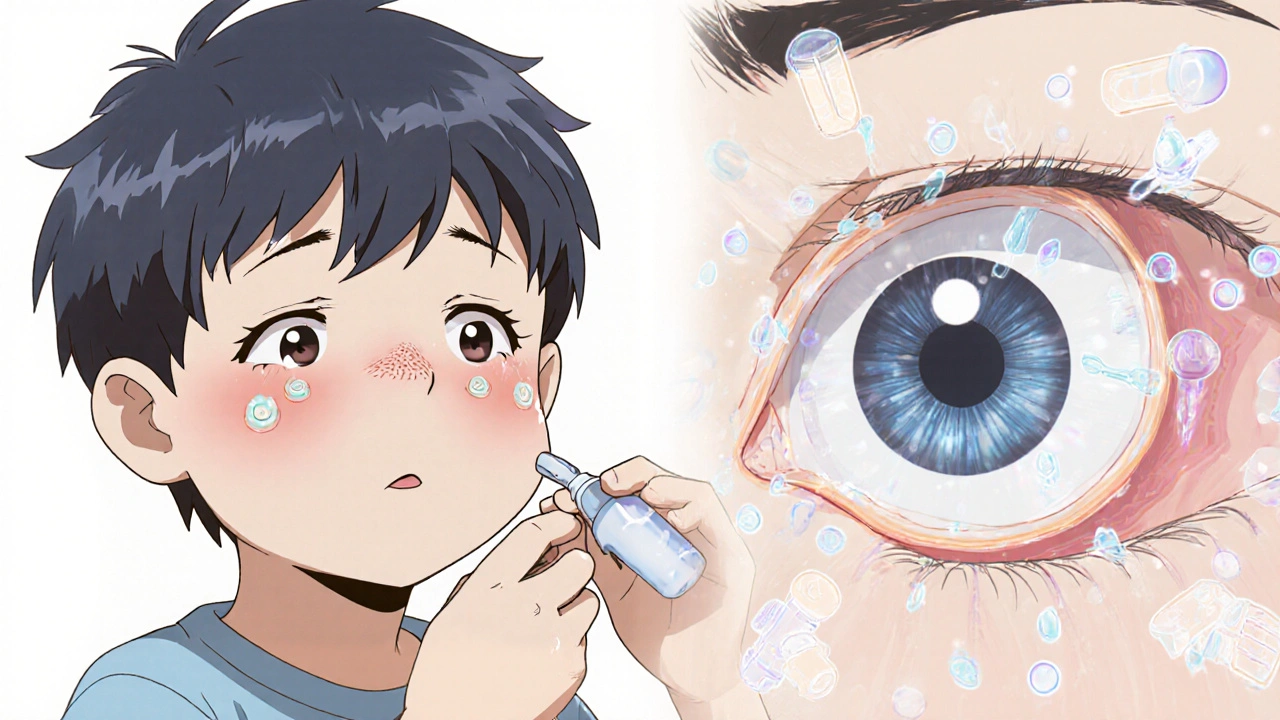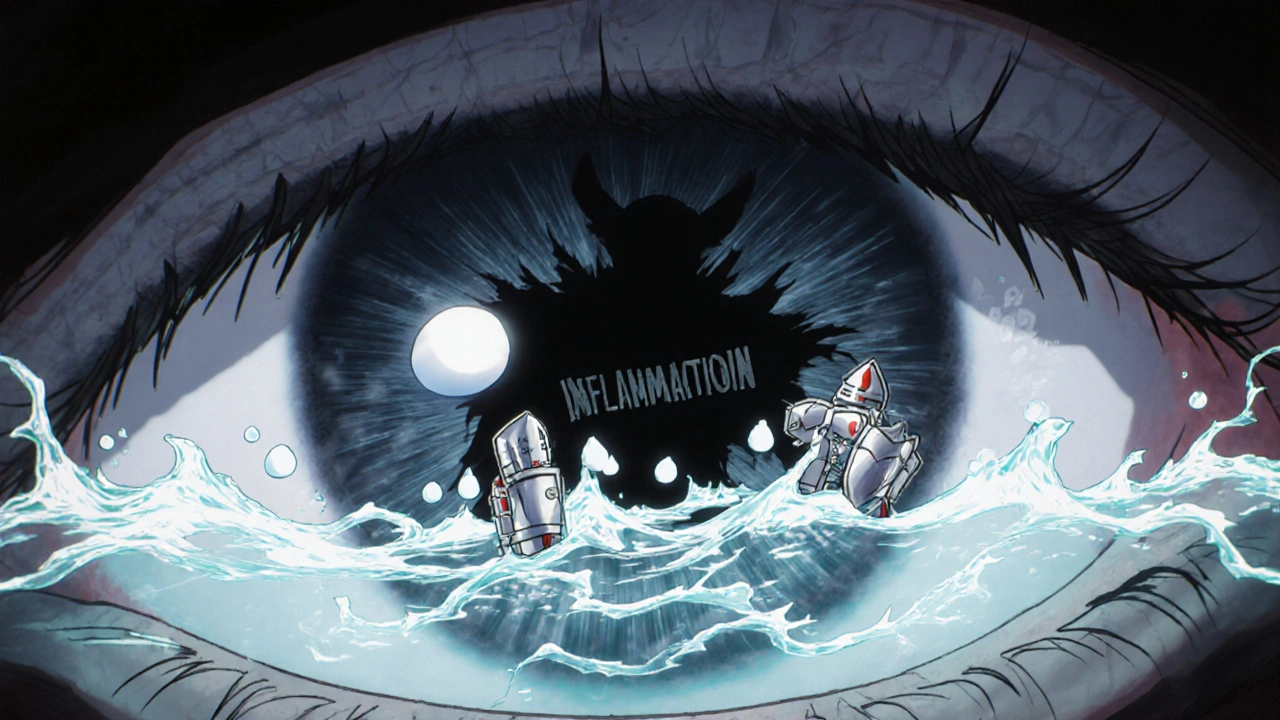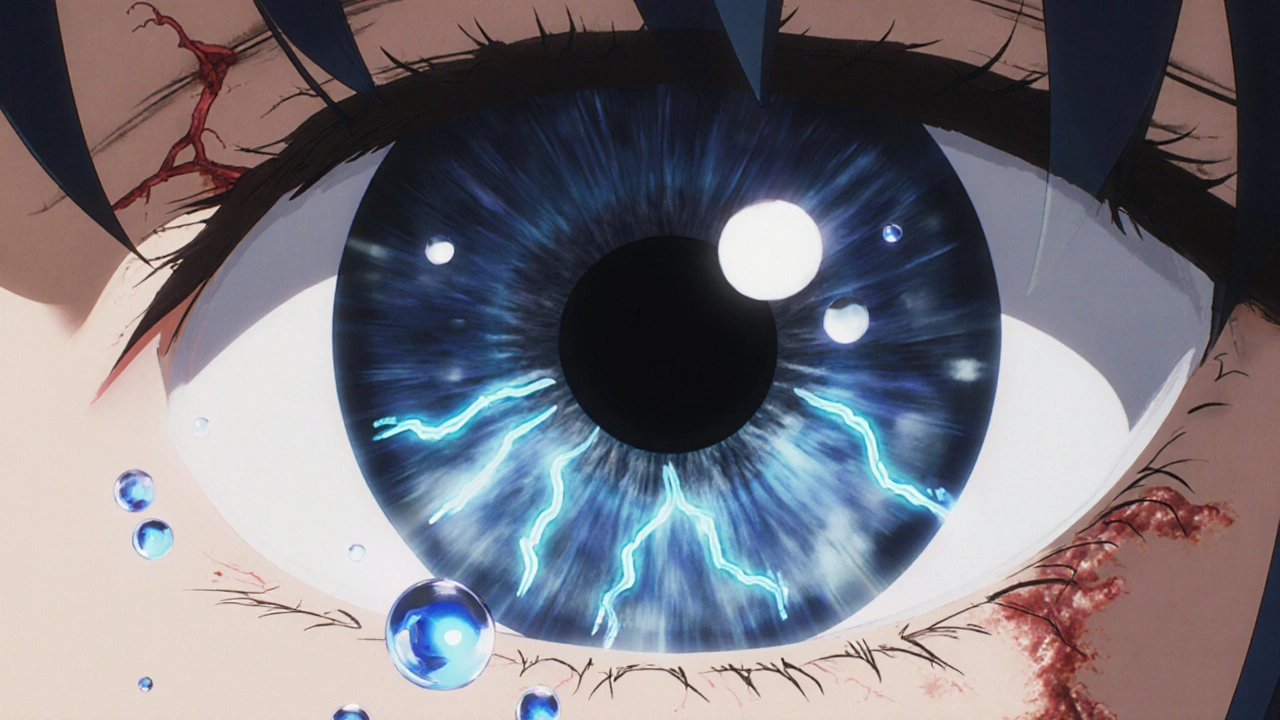Uveitic glaucoma isn’t just high eye pressure-it’s pressure caused by inflammation in the eye that blocks fluid drainage. When your uvea swells, it can clog the drainage system, leading to damage to the optic nerve. Many patients with this condition are prescribed dorzolamide, a topical eye drop that lowers pressure. But it’s not a magic fix. Some people see big improvements. Others deal with stinging, blurry vision, or even allergic reactions. Understanding how dorzolamide works-and where it falls short-is key to making smart choices.
How dorzolamide lowers eye pressure
Dorzolamide is a carbonic anhydrase inhibitor. That sounds technical, but here’s what it means in plain terms: your eye makes fluid (aqueous humor) to keep itself nourished and shaped. Normally, that fluid drains out through a mesh-like structure called the trabecular meshwork. In uveitic glaucoma, inflammation physically blocks that meshwork. Dorzolamide doesn’t unblock it. Instead, it tells the eye to make less fluid in the first place. Less fluid = lower pressure.
It’s not as strong as some other glaucoma drops like prostaglandins, but it works well when used with other medications. Studies show dorzolamide can reduce eye pressure by 15-25% in patients with uveitic glaucoma. That’s meaningful. A 2023 review in the Journal of Glaucoma found that combining dorzolamide with timolol worked better than either drug alone in controlling pressure in inflamed eyes.
What makes dorzolamide useful for uveitic glaucoma is that it doesn’t worsen inflammation. Some glaucoma drugs, like beta-blockers, can mask signs of worsening uveitis. Dorzolamide doesn’t do that. It’s one of the few pressure-lowering options that’s safe to use while you’re still fighting inflammation.
Who benefits most from dorzolamide?
Not everyone with uveitic glaucoma needs dorzolamide. It’s most helpful for people who:
- Have mild to moderate pressure spikes (21-30 mmHg)
- Are already on steroid eye drops to control inflammation
- Can’t tolerate prostaglandin analogs (like latanoprost) because of redness or eyelash growth
- Need a second medication to get pressure under control
It’s less effective in advanced cases where the drainage system is permanently scarred. If your pressure stays above 30 mmHg despite using dorzolamide, your doctor will likely add another drug or consider laser or surgery.
Children with juvenile idiopathic arthritis-related uveitis often respond well to dorzolamide. It’s one of the few glaucoma medications approved for use in kids over age 2. That’s important-pediatric uveitic glaucoma is hard to treat, and options are limited.
Common side effects you should expect
Dorzolamide is generally well-tolerated, but it’s not gentle. About 1 in 3 users report some kind of local irritation. The most common complaints:
- Burning or stinging right after putting in the drop (lasts 1-2 minutes)
- Bitter taste in the mouth (because the drop drains into your nose and throat)
- Blurred vision for 5-10 minutes after application
- Redness or itching around the eye
These aren’t dangerous, but they’re annoying enough that many people stop using it. If you’re struggling with the stinging, try refrigerating the bottle. Cold drops hurt less. Also, press your inner corner (near the nose) for 30 seconds after putting in the drop. That stops most of it from draining into your throat and reduces the bitter taste.
Some people develop an allergic reaction. That’s rare-less than 2% of users-but it’s serious. Signs include swelling of the eyelids, intense redness, or a rash around the eye. If that happens, stop using it and call your eye doctor immediately. Dorzolamide contains sulfonamide, so if you’re allergic to sulfa drugs like Bactrim or Celebrex, you should avoid it.

When dorzolamide doesn’t work-or makes things worse
There are times when dorzolamide isn’t just ineffective-it’s risky.
First, if you have kidney disease. Dorzolamide is processed by your kidneys. If they’re not working well, the drug can build up in your system. That can lead to metabolic acidosis, a condition where your blood becomes too acidic. Symptoms: fatigue, nausea, rapid breathing. Your doctor should check your kidney function before starting you on this.
Second, if you’re already using oral carbonic anhydrase inhibitors like acetazolamide. Combining them increases the risk of side effects without adding much benefit. It’s not recommended.
Third, if your uveitis is flaring badly. Dorzolamide doesn’t treat inflammation. If your eye is red, painful, and light-sensitive, lowering pressure won’t help if the inflammation isn’t under control. You need steroids or immunosuppressants first. Trying to use dorzolamide alone during a flare is like putting a bandage on a broken bone.
How to use dorzolamide correctly
Using it right makes a big difference. Most people apply it three times a day-morning, afternoon, and night. But timing matters. If you’re also using steroid drops (like prednisolone), wait at least 5 minutes between them. If you’re using multiple glaucoma drops, space them 5-10 minutes apart. Putting them in too close together means the second drop washes out the first.
Always wash your hands. Don’t let the dropper touch your eye or eyelid. That can contaminate the bottle. If you’re using a multi-dose bottle, throw it out after 4 weeks. Even if it looks fine, bacteria can grow in it.
Some people forget doses. That’s common. But missing doses can cause pressure spikes. If you forget one, don’t double up. Just skip it and go back to your regular schedule. Consistency matters more than perfect timing.

Alternatives to dorzolamide
If dorzolamide doesn’t work or causes too many side effects, here are other options:
| Medication | Pressure Reduction | Best For | Key Risks |
|---|---|---|---|
| Dorzolamide | 15-25% | Mild-moderate pressure, patients on steroids | Burning, bitter taste, sulfa allergy |
| Timolol | 20-30% | Stable pressure control | Slows heart rate, asthma risk |
| Latanoprost | 25-35% | Strong pressure lowering | Eye redness, darkens iris, eyelash growth |
| Brimonidine | 15-20% | Patients with inflammation | Drowsiness, dry mouth, low blood pressure |
| Combination drops (e.g., Cosopt) | 25-35% | Need two meds, fewer bottles | Combined side effects of both drugs |
Latanoprost is often stronger, but it can make uveitis flare-ups worse by increasing blood flow to the eye. Brimonidine is another option-it reduces fluid production and may even have anti-inflammatory effects. But it can make you tired or dizzy. Timolol works well, but if you have asthma or heart problems, it’s risky.
Combination drops like Cosopt (dorzolamide + timolol) are convenient. One bottle, two drugs. But if you’re allergic to sulfonamides, you can’t use it. And if you can’t tolerate one component, you’re stuck with the whole thing.
What to expect long-term
Dorzolamide isn’t a cure. It’s a tool to protect your vision. In long-term studies, patients who stayed on dorzolamide (with proper inflammation control) had slower optic nerve damage than those who didn’t. But it’s not enough on its own. Regular eye exams every 3-6 months are non-negotiable. Your doctor needs to check your pressure, your optic nerve, and your inflammation levels.
Some people use dorzolamide for years. Others switch after 6-12 months when their uveitis stabilizes and they need stronger pressure control. There’s no rule. It depends on your body, your inflammation pattern, and how well you respond.
If you’ve been on dorzolamide for over a year and your pressure is still above 20 mmHg, it’s time to talk about other options. Waiting too long increases your risk of permanent vision loss.
When to call your doctor
Call your eye doctor right away if you notice:
- Sudden vision loss or worsening blurry vision
- Severe eye pain or headache
- Swelling or rash around the eye
- Difficulty breathing after using the drops
- Signs of infection: pus, increased redness, fever
These aren’t common, but they’re serious. Don’t wait to see if it gets better.
Can dorzolamide cure uveitic glaucoma?
No. Dorzolamide lowers eye pressure, but it doesn’t treat the underlying inflammation that causes uveitic glaucoma. You still need anti-inflammatory medications like steroids or immunosuppressants to control the root problem. Dorzolamide protects your vision by reducing pressure, but it’s not a cure.
Is dorzolamide safe for children?
Yes, dorzolamide is approved for children over age 2 with uveitic glaucoma, especially those with juvenile idiopathic arthritis. It’s often preferred because it doesn’t affect heart rate or breathing like some other glaucoma drugs. But it still causes stinging and bitter taste, so compliance can be a challenge. Parents should work with their pediatric ophthalmologist to find the best routine.
Can I use dorzolamide if I’m allergic to sulfa drugs?
No. Dorzolamide contains a sulfonamide component. If you’ve had a serious allergic reaction to sulfa antibiotics like sulfamethoxazole or sulfonylurea diabetes drugs, you should avoid dorzolamide. Mild reactions like stomach upset from sulfa drugs don’t always mean you can’t use it-but you should talk to your doctor. A patch test or trial under supervision might be considered in rare cases.
How long does it take for dorzolamide to start working?
You’ll usually see a drop in eye pressure within 1-2 hours after the first dose. The full effect takes about 2-4 weeks of consistent use. Don’t stop using it if you don’t feel immediate results. Glaucoma damage happens slowly, and the benefit is long-term protection, not instant relief.
Can dorzolamide cause permanent eye damage?
Not directly. But if you ignore side effects like allergic reactions or stop using it because of discomfort, your eye pressure can rise again. Uncontrolled pressure leads to optic nerve damage and permanent vision loss. The drug itself doesn’t harm your eye-it’s the untreated pressure that does.
If you’re managing uveitic glaucoma, dorzolamide can be a valuable part of your treatment plan. But it’s not a standalone solution. It works best when paired with inflammation control, regular monitoring, and honest communication with your eye care team. Don’t tolerate side effects in silence-there are alternatives. And don’t assume it’s working just because you don’t feel pain. Glaucoma doesn’t warn you. It steals vision quietly. That’s why sticking to your schedule and showing up for checkups is the real key to keeping your sight.


Been on dorzolamide for 18 months now. The stinging? Still sucks. But the bitter taste? I’ve learned to love it-like a weird, medicinal mint. Cold bottle, press the inner corner, and boom-barely notice it. My pressure’s been stable at 16 since I started. No miracles, just consistency.
Let’s be real-dorzolamide is the pharmaceutical equivalent of duct tape on a Ferrari. It’s not elegant, it’s not powerful, but it’s what you get when you’re too scared to go full nuclear with oral CAIs. Also, anyone who says ‘it doesn’t worsen inflammation’ is ignoring the fact that it’s a sulfonamide. If you’re allergic to sulfa, you’re playing Russian roulette with your cornea. Just sayin’.
My kid’s been on it since age 4. The bitter taste makes him gag every time. We keep the bottle in the fridge. He now calls it ‘the cold medicine that tastes like regret.’ He’s 12 now. Vision’s fine. He hates it. I hate giving it to him. But we do it anyway. Because vision doesn’t come back.
Hey everyone, just wanted to say-this is one of the clearest, most compassionate breakdowns of uveitic glaucoma meds I’ve ever read 🙌
For those struggling with the sting: try freezing the dropper tip for 10 mins before use. Game changer. Also, if you’re on steroids, space them 10 minutes apart. I used to slam them back-to-back and wonder why my pressure spiked. Duh. 🤦♂️
And yes-dorzolamide won’t cure your uveitis. But it’s a quiet hero keeping your optic nerve alive while you fight the real enemy. Keep showing up for your drops. You’re doing better than you think.
Dorzolamide is useless if you dont take it right. I missed 3 days and my pressure went to 34. Duh. Also dont use it if you have kidney issues. I did. Got acidosis. Was in the ER. Now I know. Learn from my dumbass.
It is deeply concerning that so many individuals treat ocular hypertension as a trivial matter to be managed with over-the-counter advice and anecdotal remedies. Dorzolamide is a prescription pharmaceutical agent, not a lifestyle supplement. The casual dismissal of contraindications, particularly in the context of sulfonamide allergies and renal impairment, is not merely irresponsible-it is potentially lethal. One must approach ophthalmic therapeutics with the gravity they deserve.
Bro this whole post is just a fancy ad for dorzolamide. Like yeah it lowers pressure. So does a needle in the eyeball. Why not just say ‘use less water in your eye’? Also I heard someone on TikTok say pineapple cures glaucoma. I’m gonna try that before I waste money on this.
Let me just say-this is the most clinically accurate, emotionally intelligent piece I’ve read in months. 🌟
And to the guy who said pineapple cures glaucoma? Honey, your TikTok algorithm is running a horror show.
Also-yes, the bitter taste is the worst. But imagine if your vision vanished because you skipped a dose because ‘it tasted like regret.’
Don’t be that person. Your future self will thank you. 💪👁️
Just had to comment because I’m one of those ‘allergic to sulfa’ people who used dorzolamide anyway. 🤡
Swelling. Itching. Felt like my eyelid was being stabbed by tiny bees. Took 3 days to go down. Now I’m on brimonidine. Less stinging. More drowsiness. At least I’m not in the ER.
Lesson learned: if your doctor says ‘maybe it’s fine,’ say ‘nope.’
Also-why does this drug taste like a chemistry lab exploded in my mouth? 😭
While the author presents a seemingly comprehensive overview, one cannot help but notice the profound epistemological gap between clinical data and patient lived experience. The reductionist framing of dorzolamide as a mere ‘pressure-lowering tool’ neglects the existential burden of chronic ocular pharmacotherapy. The bitter aftertaste is not merely a pharmacokinetic artifact-it is a daily reminder of corporeal vulnerability. The 15-25% pressure reduction statistic is statistically significant, yet ethically hollow when juxtaposed against the daily ritual of self-administered discomfort. We are not patients. We are pharmacological test subjects in a body that refuses to cooperate.
So… dorzolamide doesn’t fix the inflammation. Just lowers the pressure. So if your eye is inflamed and you’re on this, you’re basically just hiding the fire while the house burns down? Interesting. So why not just say ‘this is a band-aid for a bullet wound’?
My doctor gave me this after I cried in his office about the redness from latanoprost. Dorzolamide? More like dorzolameh. Stings like hell. Bitter as a bad breakup. But hey, at least my pressure’s down. I still use it. I just do it in the dark so I don’t see how gross it is. Also I forgot to wash my hands once. Bottle’s probably full of germs now. Oh well. It’s not like my eye can get any more angry.